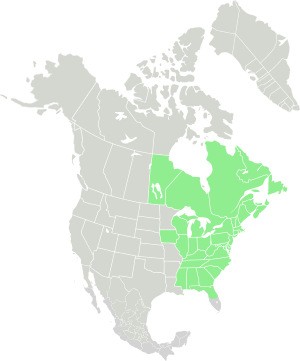American cancer-root facts for kids
Quick facts for kids American cancer-root |
|
|---|---|
 |
|
| Conservation status | |
| Scientific classification | |
| Genus: |
Conopholis
|
| Species: |
americana
|
 |
|
| Range of Conopholis americana | |
| Synonyms | |
|
Orobanche americana L. |
|
Conopholis americana, also known as American cancer-root, squawroot, bumeh, or bear corn, is a really unique plant! It's a perennial plant, meaning it lives for more than two years. What's special about it is that it doesn't make its own food using sunlight like most plants. Instead, it's a parasitic plant, which means it gets its food from other plants. It belongs to the family Orobanchaceae. When it blooms, it looks a lot like a pine cone or an ear of corn growing right out of the ground, usually near the roots of oak and beech trees. Native American women used this plant to help with menstrual cramps and other female health issues, which is how it got some of its common names.
Contents
Meet the Bear Corn Plant
The American cancer-root is a parasite that lives on the roots of woody plants, especially oak trees (from the genus Quercus) and beech trees (from the genus Fagus). The part of the plant you usually see is its cone-shaped flower stalk, which pops up above the ground in the spring.
The whole plant is a yellowish color. As it gets older, it turns brown. It can grow to be about 4 to 8 inches (10 to 20 cm) tall.
Stems and Leaves
The stems of the bear corn plant are thick and don't have branches. They are about 0.5 to 1 inch (1.3 to 2.5 cm) wide.
Since Conopholis americana doesn't make its own food through photosynthesis, it doesn't have regular green leaves. Instead, it has small, oval-shaped, brown scales that are about 0.5 inches (1.3 cm) long. These scales are found at the base of each flower.
Flowers
The American cancer-root produces many yellow to cream-colored flowers that are packed closely together all around its stem. Each flower has five parts and is about 0.3 to 0.5 inches (8 to 13 mm) long. They are shaped like a tube with a swollen bottom and face downwards. As the flower stalk gets older, it starts to dry out and turn brown during the summer. It often stays like this through the winter, becoming shriveled and black. These flowers do not have any noticeable smell.
Fruits and How it Spreads
After the flowers bloom, each one turns into a seed capsule. These capsules are longer than they are wide and hold many tiny seeds. This plant spreads to new places by dropping these seeds.
Roots and How it Feeds
The root system of the bear corn plant is special because it's parasitic. It attaches itself to the roots of oak trees (Quercus species). The plant depends on the oak tree for all its food and water. Its special "suckers," called haustoria, attach to the host tree's roots. These suckers cause large, rounded bumps to form on the roots of the oak tree.
Where Does it Grow?
You can find Conopholis americana growing on roots in wooded areas, especially in ravines, across the eastern United States. It grows in every state east of the Mississippi River.
Native to:
- North America:
* Eastern Canada: Nova Scotia, Ontario, Quebec * Northeastern U.S.A.: Connecticut, Indiana, Maine, Massachusetts, Michigan, New Hampshire, New York, New Jersey, Ohio, Pennsylvania, Rhode Island, Vermont, West Virginia * North-Central U.S.A.: Illinois, Wisconsin * Southeastern U.S.A.: Alabama, Delaware, Florida, Georgia, Kentucky, Maryland, North Carolina, South Carolina, Tennessee, Virginia
In some areas, this plant needs special protection. It is considered an exploitably vulnerable species in New York, which means it could become endangered if people aren't careful. It's a threatened species in New Hampshire, meaning it's likely to become endangered in the near future. And in Rhode Island, it's a "special concern" species, meaning it needs monitoring because of potential threats.


